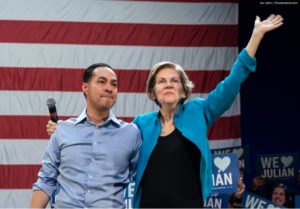By Timothy Taylor, Managing Editor of the Journal of Economic Perspectives
The COVID-19 pandemic is an intertwined public health and economic event. Here are some comments from Richard Baldwin and Beatrice Weder di Mauro: “The social distancing policies are purposefully inducing an economic slowdown. … The recession, so to speak, is a necessary public health measure. … The recession is a medical necessity. That’s a given. But governments can and should try to flatten the economic recession curve. … The key is to reduce the accumulation of ‘economic scar tissue’ – reduce the number of unnecessary personal and corporate bankruptcies, make sure people have money to keep spending even if they are not working.”
The comments are from the “Introduction” to an e-book containing 24 short essays edited by Baldwin and Weder di Mauro, and just released by VoxEU: Mitigating the COVID Economic Crisis: Act Fast and Do Whatever It Takes. This is a follow-up to the ebook they produced less than two weeks ago, which I commented on in “Some Coronavirus Economics” (March 11, 2020). The collection has a lot of interesting analysis about fiscal and monetary policy in the current setting, along with specific discussions of the European Union, the European Central Bank, Italy, Germany, China, Singapore, South Korea, and so on.
[I]n the short run, flattening the infection curve inevitably steepens the macroeconomic recession curve. Consider China, or Italy: increasing social distances has required closing schools, universities, most non-essential businesses, and asking ost of the working-age population to stay at home. While some people may be able to work from home, this remains a small fraction of the overall labour force. Even if working from home is an option, the short-term disruption to work and family routines is major and likely to affect productivity. In short, the – appropriate – public health policy plunges the economy into a sudden stop. … A modern economy is a complex web of interconnected parties: employees, firms, suppliers, consumers, banks and financial intermediaries… Everyone is someone else’s employee, customer, lender, etc. A sudden stop like the one described above can easily trigger a cascading chain of events, fuelled by individually rational, but collectively catastrophic, decisions. … To a first-order approximation, I would consider that governments may need to provide income support on a scale roughly comparable to the output lost.
3) As another matter of practical politics, support for business often tends to favor the big and the prominent. For example, in a US context there has been talk of assisting the airlines, which are big prominent companies, often with unionized employees, and thus lots of political clout. However, the tourism, entertainment, and restaurant industry is made up of much smaller firms, although as a group, they employ vastly more people.
4) It’s easy to say that companies shouldn’t be forced into bankruptcy by the coronavirus, and by and large, I agree. But we all know that some economic actors are more prudent than others. Some companies take on very high levels of debt, and some don’t. Some people make sure to an amount equal to several months of income on hand, and others (who have similar levels of income) are rolling over large credit-card bills and paying interest from month to month. Yes, the pandemic was unexpected, but some firms and people build in a cushion deal with the unexpected, and some don’t. Whenever government steps in to help those who are blindsided by an unexpected event, it benefits those who were not prudent over those who tried to be.
5) Finally, I’ll add that any economy is not just a machine that can be switched off and on again. Helping households and firms to limp through the economic effects of this pandemic is worth doing, even at high costs to governments. But the economic disruption has costs of its own. Some number of the projects that companies were working on will be forever uncompleted. Relationships within and across organizations have been disrupted. It seems unlikely that customers and supply chains will simply restart their old patterns after a substantial disruption. Trust in providers will be shaken, sometimes for good reasons and sometimes for trivial ones. There may be jump-starts toward companies doing more work online, or encouraging telecommuting. In health care, there may be shifts toward virtual consultations, or pharmacists providing more services, or how tests and treatments are approved and used. There may be surge to online education: after all, if online education is good enough for grades and credit at Harvard, Stanford, doesn’t that show that it could be online at lots of other places after the pandemic passes? These pattern shifts and many more will outlast the pandemic itself, and will cause economic disruptions and costs of their own.
Timothy Taylor is Managing editor of the Journal of Economic Perspectives, based at Macalester College in St. Paul, Minnesota, which can be read free on-line courtesy of the American Economic Association
Note: The views expressed in this article are the author/s, and not the position of Intellectual Dose, or iDose (its online publication). This article is republished with permission from The Conversable Economist



